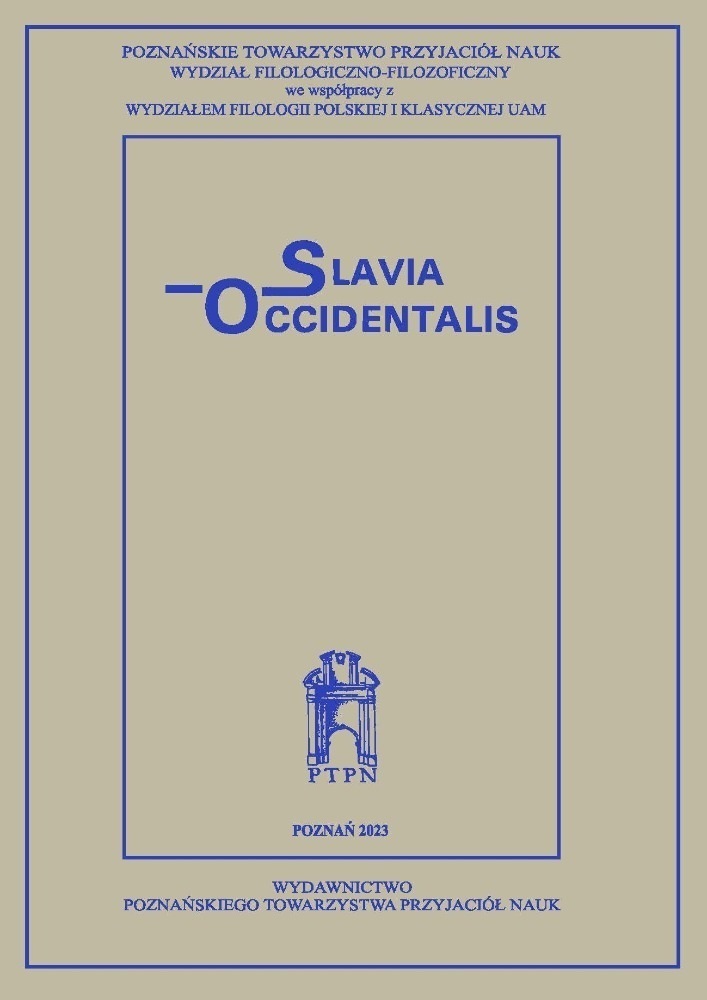Abstract
The teaching of Upper Sorbian (USo) is of increasing importance for the survival of this language. A challenge faced by learners is the lack of standardisation. Reliable standardisation has been conducted only in the area of orthography, which offers little indication about pronunciation. Pronunciation, however, is generally missing in all USo dictionaries, and teaching materials offer only general observations. Learners of USo mostly belong to one of two groups which require different teaching strategies: on the one hand, second-language learners aim to achieve authentic pronunciation; native speakers, on the other hand, struggle with the contrast between the standardised etymological orthography and the phonetic representation in everyday language (partly addressed in Šołćina 2014a/b).References
de Meulder M., Werner E., de Weerdt D., 2017: Comparing Minority Languages – a Case Study of Flemish Sign Language and Upper Sorbian, “Europäisches Journal für Minderheitenfragen” 3–4(2017), pp. 287–321.. DOI: https://doi.org/10.35998/ejm-2017-0016
Dorian N., 1977, The Problem of the Semi-Speaker in Language Death, “International Journal of the Sociology of Language”, Volume 1977, Issue 12, pp. 23–32, New York. DOI: https://doi.org/10.1515/ijsl.1977.12.23
Faska H. (ed.), 1998, Najnowsze dzieje języków słowiańskich: Serbšćina [=The newest changes in Slavic languages: Sorbian], Opole.
Faska H., 2003, Pućnik po hornjoserbšćinje. [=Guide to Upper Sorbian], Budyšin.
Faßke H., 1981, Grammatik der obersorbischen Schriftsprache der Gegenwart: Morphologie / unter Mitarbeit von S. Michalk. [=Grammar of the contemporary USo standard language], Bautzen.
Faßke H., Jentsch H., Michalk S., 1965-1996, Sorbischer Sprachatlas in 15 Bänden [=Sorbian language atlas in 15 tomes], Bautzen.
Finegan E., 2007, Language: Its Structure and Use (5th ed.), Boston, MA, USA.
Fishman J.A., 1991, Reversing Language Shift: Theoretical and Empirical Foundations of assistance to threatened languages, No. 76, “Multilingual matters”. DOI: https://doi.org/10.2307/330061
Heinz S., 2003, Welsh dictionaries in the 20th century: a critical analysis, “LINCOM Studies in Indoeuropean Linguistics” 21, LINCOM Europa
Jentsch H., 1989/91, Deutsch-obersorbisches Wörterbuch [=German-Upper Sorbian dictionary.], Bautzen.
Jentsch H., 1999, Die Entwicklung der Lexik der obersorbischen Schriftsprache vom 18. Jahrhundert bis zum Beginn des 20. Jahrhunderts [= The development of the lexicon of written Upper Sorbian from the 18th century until the beginning of the 20th century], “Schriften des Sorbischen Instituts 22”, Bautzen.
Jocz L., 2014, Studien zum obersorbischen Konsonantismus [=Studies on the Upper Sorbian consonant system], academia.edu.
Kretschmer A., 1999, Einige Beobachtungen zur Sprachnorm (am Material der Sprache der obersorbischen Medie vor und nach der Wende)” [=Some observations on language norm (with examples of Upper Sorbian in the media before and after the reunion of Germany)], “Lětopis 46 Wosebity zešiwk”, pp. 218-225, Bautzen.
Nevins A., Rodrigues C., Tang K., 2015, The Rise and Fall of the L-Shaped Morphome: Diachronic and Experimental Studies, To appear in “Probus. doi: 10.1515/probus-2015-0002”. DOI: https://doi.org/10.1515/probus-2015-0002
Norberg M. (ed.), 2006, Das bilinguale Sprachprogramm WITAJ in der Kindertagesstätte und in der Schule in der Niederlausitz. Einblicke und Ausblicke [=The bilingual language programme WITAJ in kindergartens and schools in Lower Lusatia], Bautzen.
Norberg M. (ed.), 2010, WITAJ in Brandenburg. Stand und Weiterentwicklung eines erfolgreichen bilingualen Sprachprogramms. Überarbeitete Konzeption [=WITAJ in Brandenburg. State and development of a successful bilingual language programme. Revised conception], Bautzen.
Rězak F., 1920, Němsko-serbski wšowědny słownik hornjołužiskeje rěče. Deutsch-wendisches encyklopädisches Wörterbuch der oberlausitzer Sprache. [=German-Sorbian encyclopedic dictionary of the Upper Lusatian language], Bautzen.
Šěnowa K., 2015, Eksistencne formy hornjoserbšćiny a konsekwency za wuwučowanje na dwurěčnych šulach. [=Forms of existence of USo and consequences for teaching on bilingual schools.], unpublished BA thesis, Leipzig.
Scholze L., 2008, Das grammatische System der obersorbischen Umgangssprache im Sprachkontakt. Domowina-Verlag [=The grammatical system of the USo Vernacular in language contact], Bautzen.
Schulz J., 2015, Bilingualer Spracherwerb im Witaj-Projekt. [=Bilingual language acquisition in the WITAJ project.], Bautzen.
Schuster-Šewc H., 1966/1984, Gramatika hornjoserbskeje rěče. Zwjazk 1.: Fonologija, fonetika a morfologija [=Upper Sorbian Grammar. Part 1: Phonology, phonetics and morphology], Budyšin.
Šołćina J. et al., 2014a, Naša maćeršćina: wučbnica za 8. lětnik serbskich wyšich šulow a serbskeho gymnazija, Budyšin 2014 [=Our mother-tongue: course book for the 8. class of USo secondary schools and grammar schools], Budyšin.
Šołćina J. et al., 2014b, Zwučujemy a pisamy: dźěłowy zešiwk za 8. lětnik serbskich wyšich šulow a serbskeho gymnazija [=We practise and write: working sheets for the 8. class of USo secondary schools and grammar schools], Budyšin.
Šołćina J., Wornar E., 2000, 2005, 2012, Hornjoserbšćina w samostudiju. Kurs za njebojaznych [=USo for self-study], Budyšin.
Tomčík S., 2016, in press “Sorbian in the Linguistic Landscape of Budyšin/Bautzen Town Centre”, proceedings of LAUFD 2016.
UNESCO Ad Hoc Expert Group on Endangered Languages, 2003, Language Vitality and Endangerment. Document submitted to the “International Expert Meeting on UNESCO Programme Safeguarding of Endangered Languages”, Paris.
Völkel P., 2005, Prawopisny słownik hornjoserbskeje rěče. Hornjoserbsko-němski słownik / Obersorbisch- deutsches Wörterbuch, revised by Timo Meškank. 6. edition 2014, Budyšin.
Walde M., 2004, Demographisch-statistische Betrachtungen im Oberlausitzer Gemeindeverband Am Klosterwasser [=Demographic and statistical observations in the Upper Lusatian region Am Klosterwasser], “Lětopis 51”, p. 1, pp. 3–27, Bautzen.
Werner E., 1996, Studien zum sorbischen Verbum. [=Studies on the Sorbian verb], Bautzen.
Werner E., 2003, Die Verbalaffigierung im Obersorbischen. [=Verbal affixation in Uso], Bautzen.
Wornar E., 1999, Analytiski futur perfektiwnych werbow w hornjoserbšćinje [=The analytic future tense of perfective verbs in USo], “Lětopis 46 Wosebity zešiwk”, pp. 168–172, Budyšin.
Wornar E., 2007, Wo změnach w paradigmatice femininowych a-zdónkow w dźensnišej hornjoserbšćinje [=On changes in the feminine a-stems in contemporary USo], “Lětopis 54”, pp. 103–109, Budyšin.
Wowčerk P., 1951, Kurzgefaßte Grammatik der obersorbischen Sprache, Bautzen.
License
Copyright (c) 2017 Eduard Werner

This work is licensed under a Creative Commons Attribution-NonCommercial-NoDerivatives 4.0 International License.
